The ASUS Maximus VIII Extreme Review: The Other $500 Option
by Ian Cutress on April 7, 2016 9:00 AM EST- Posted in
- Motherboards
- Gaming
- Asus
- ROG
- Skylake
- Z170
- Thunderbolt 3
Gaming Performance 2015
Our 2015 gaming results are still relatively new, but the issue of FCLK settings might play a big role here. At launch, the default setting for the communication buffer between the CPU and PCIe stack was 800 MHz, even though Intel suggested 1000 MHz, but this was because of firmware limitations from Intel. Since then, there is firmware to enable 1000 MHz, and most motherboard manufacturers have this - but it is unclear if the motherboard will default to 1000 MHz and it might vary from BIOS version to BIOS version. As we test at default settings, our numbers are only ever snapshots in time, but it leads to some interesting differences in discrete GPU performance.
Alien: Isolation
If first person survival mixed with horror is your sort of thing, then Alien: Isolation, based off of the Alien franchise, should be an interesting title. Developed by The Creative Assembly and released in October 2014, Alien: Isolation has won numerous awards from Game Of The Year to several top 10s/25s and Best Horror titles, ratcheting up over a million sales by February 2015. Alien: Isolation uses a custom built engine which includes dynamic sound effects and should be fully multi-core enabled.
For low end graphics, we test at 720p with Ultra settings, whereas for mid and high range graphics we bump this up to 1080p, taking the average frame rate as our marker with a scripted version of the built-in benchmark.
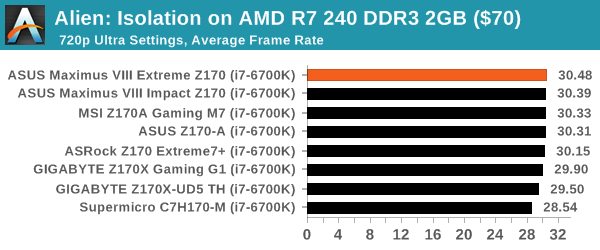
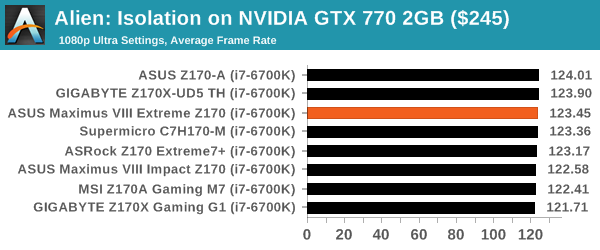
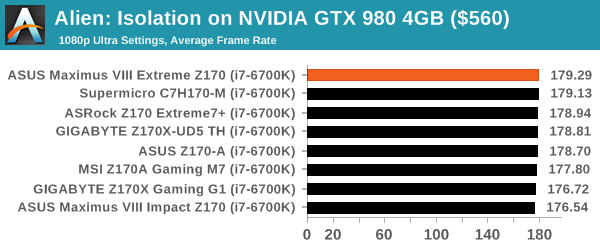
Total War: Attila
The Total War franchise moves on to Attila, another The Creative Assembly development, and is a stand-alone strategy title set in 395AD where the main story line lets the gamer take control of the leader of the Huns in order to conquer parts of the world. Graphically the game can render hundreds/thousands of units on screen at once, all with their individual actions and can put some of the big cards to task.
For low end graphics, we test at 720p with performance settings, recording the average frame rate. With mid and high range graphics, we test at 1080p with the quality setting. In both circumstances, unlimited video memory is enabled and the in-game scripted benchmark is used.
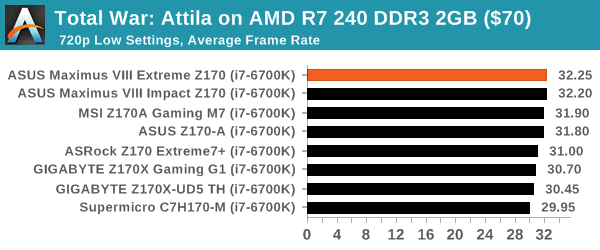
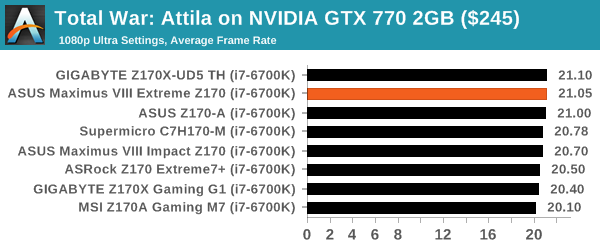
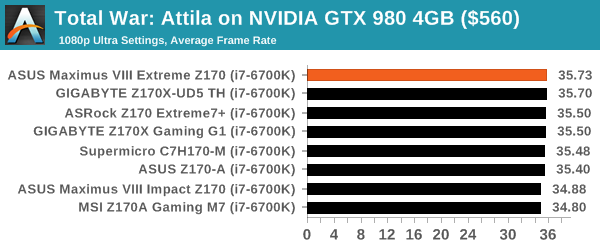
Grand Theft Auto V
The highly anticipated iteration of the Grand Theft Auto franchise finally hit the shelves on April 14th 2015, with both AMD and NVIDIA in tow to help optimize the title. GTA doesn’t provide graphical presets, but opens up the options to users and extends the boundaries by pushing even the hardest systems to the limit using Rockstar’s Advanced Game Engine. Whether the user is flying high in the mountains with long draw distances or dealing with assorted trash in the city, when cranked up to maximum it creates stunning visuals but hard work for both the CPU and the GPU.
For our test we have scripted a version of the in-game benchmark, relying only on the final part which combines a flight scene along with an in-city drive-by followed by a tanker explosion. For low end systems we test at 720p on the lowest settings, whereas mid and high end graphics play at 1080p with very high settings across the board. We record both the average frame rate and the percentage of frames under 60 FPS (16.6ms).
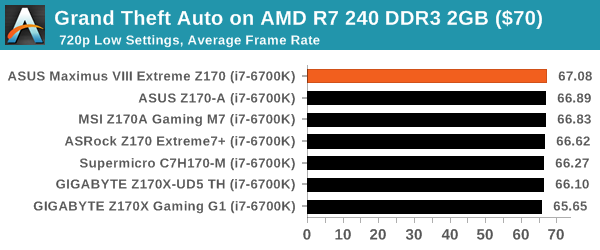
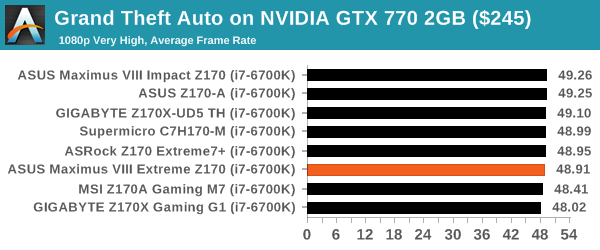

GRID: Autosport
No graphics tests are complete without some input from Codemasters and the EGO engine, which means for this round of testing we point towards GRID: Autosport, the next iteration in the GRID and racing genre. As with our previous racing testing, each update to the engine aims to add in effects, reflections, detail and realism, with Codemasters making ‘authenticity’ a main focal point for this version.
GRID’s benchmark mode is very flexible, and as a result we created a test race using a shortened version of the Red Bull Ring with twelve cars doing two laps. The car is focus starts last and is quite fast, but usually finishes second or third. For low end graphics we test at 1080p medium settings, whereas mid and high end graphics get the full 1080p maximum. Both the average and minimum frame rates are recorded.


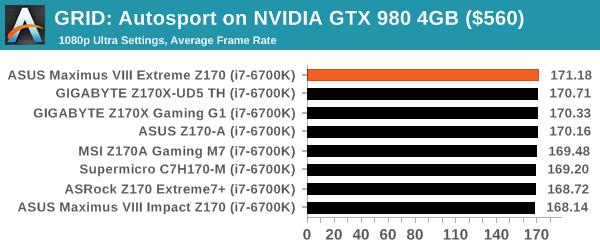
Middle-Earth: Shadow of Mordor
The final title in our testing is another battle of system performance with the open world action-adventure title, Shadow of Mordor. Produced by Monolith using the LithTech Jupiter EX engine and numerous detail add-ons, SoM goes for detail and complexity to a large extent, despite having to be cut down from the original plans. The main story itself was written by the same writer as Red Dead Redemption, and it received Zero Punctuation’s Game of The Year in 2014.
For testing purposes, SoM gives a dynamic screen resolution setting, allowing us to render at high resolutions that are then scaled down to the monitor. As a result, we get several tests using the in-game benchmark. For low end graphics we examine at 720p with low settings, whereas mid and high end graphics get 1080p Ultra. The top graphics test is also redone at 3840x2160, also with Ultra settings, and we also test two cards at 4K where possible.
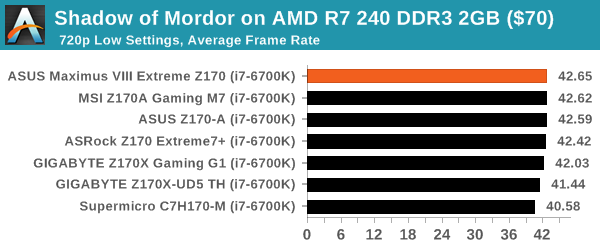
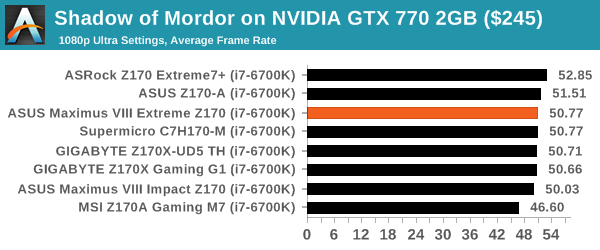

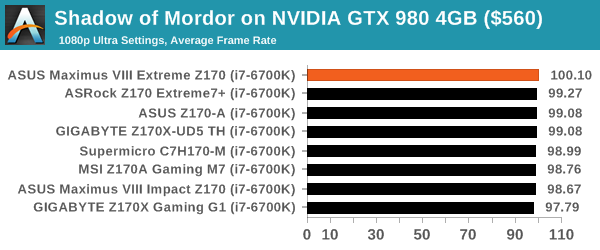
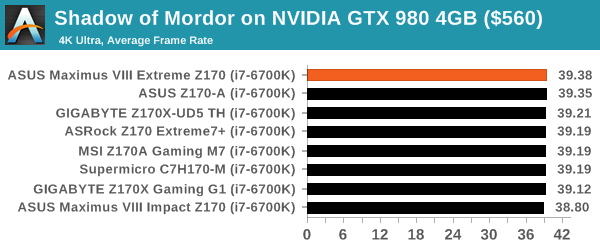















70 Comments
View All Comments
BrokenCrayons - Thursday, April 7, 2016 - link
"Yes, blowing that much money on frivolous casual dining, outings and shopping is obviously a demonstration of financial brilliance!"It most certainly isn't wasted money and is part of my "fun cash" allotment to myself after bills are paid and my savings and retirement funds are given their budgeted amounts. So what you're effectively seeing is the result of financial planning and numerous years strictly sticking to a budget. It's not brilliance, but it is a very regimented commitment to a monetary standard.
sweenish - Thursday, April 7, 2016 - link
What you're failing to understand is that "wasted" money to you is not necessarily wasted money to someone else.You're way of doing things is not universal, and neither is how you decide to spend your money for fun. Get over yourself.
BrokenCrayons - Friday, April 8, 2016 - link
I don't think you actually read the chain of posts above yours fully before replying. It doesn't seem like you've comprehended the nuances of the discussion prior to developing feelings about it.A5 - Thursday, April 7, 2016 - link
I don't think anyone buying a $500 motherboard runs in social circles that have the same priorities as you do.It's obviously an insane product, but I assume it brings in a decent profit at low volumes.
ASEdouardD - Thursday, April 7, 2016 - link
As with most things, the rationality of spending that much on a motherboard really depends on how much money you have to spend. If you make 500k a year and like this stuff, why the hell not.Murloc - Thursday, April 7, 2016 - link
yeah people who buy this stuff, besides a few extreme overclockers, are usually rich kids who get into this stuff and just buy the best.They're paying a premium but that premium isn't too much for them so that's good for asus and everybody else.
haukionkannel - Friday, April 8, 2016 - link
Well, I have old Extreme board and the best part is that it has been a trouble free instrument in my setting. The Mother board is now 8-9 years old and still working perfectly!You pay for quality components. I have done only very minor overclocking and preferred stability and durability over maximum performance.
Azethoth - Saturday, April 9, 2016 - link
I just built my Mom a new computer. The last one lasted 7 years. The new one has a Maximus VIII Hero from Fry's. If Fry's stocked the extreme I would have bought that, but limited time meant not waiting for an Amazon delivery. Assuming the same 7 year life span (old comp still worked, just not compatible with 8TB drives), it is less than $100 a year for the MB. Like the old one it is not overclocked and the extra lifespan from better components means I do not have to worry about it like I used to when she got Dells. Does she need 64GB of memory, nope. 2TB Samsung Pro? Nope. 2 8TB HGST He8 drives for the raid, nope. Netgear M4100-D12G switch with all shielded CAT7 cabling? Nope. Thermaltake Core 71 case? Nope, but she wanted a taller case so it is easier to put stuff on top of it and 71 sounds like better quality than 51.Is it worth maxing as much as possible? Yep. I anticipate that this machine will last 10 years and never break, unless 4k VR home movies suddenly becomes a thing and she gets into it and I have to fill up a few more drive bays or get a stupid expensive NAS. Oh yeah and Ashes of the Singularity is gonna scream.
Gastec - Thursday, September 22, 2016 - link
Get outta here! 500 bucks is pocket change, I pay more to fill up my Reventón every week :)arayoflight - Thursday, April 7, 2016 - link
Is there anything meaningful that it offers over Z170 deluxe, which is I guess the only option of you want fast onboard WiFi.